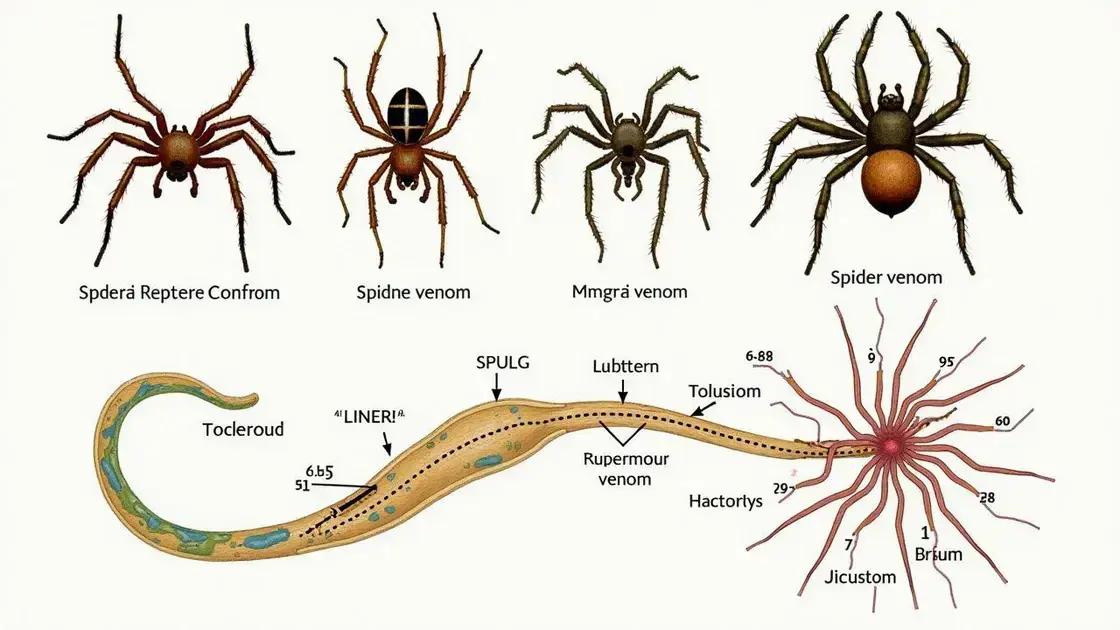The mechanics behind the spider venom trick involve complex biological processes where venom is used to immobilize prey through neurotoxins. Studying spider venom has significant implications for medicine, potentially leading to new painkillers and treatments for various diseases, while also presenting challenges in research and safety testing.
Spider venom is not just a tool for hunting; it’s a complex cocktail of proteins and enzymes that fascinates scientists. In this article, we unravel the mechanics behind the spider venom trick, exploring its unique components and how they interact with biological systems. Moreover, we will understand the potential applications of this venom in medicine and research, showcasing its importance beyond the arachnid world. Are you ready to dive into the fascinating world of spider venom?
The Science of Spider Venom

Spider venom is a complex mixture of proteins and peptides that serve various functions in nature. These toxins are primarily designed to immobilize and digest prey, but they also have potential uses in medicine. Understanding the science behind spider venom reveals fascinating insights into its components and mechanisms.
Composition of Spider Venom
Spider venom typically contains enzymes, neurotoxins, and proteins. Each component plays a specific role. For example, neurotoxins can paralyze prey, while enzymes break down tissues, allowing the spider to digest its meal externally. The unique composition varies across different spider species, contributing to their diverse hunting strategies.
How Spider Venom Affects the Body
When injected into a victim, spider venom interacts with specific biological processes. It can disrupt nerve signals, impairing muscle control and triggering pain responses. This complex interaction is what makes studying spider venom so intriguing for scientists, as they seek to understand how these toxins work at a cellular level.
Research on Spider Venom Applications
Research into spider venom has led to potential applications in medicine. Some studies suggest that particular components could be used as painkillers or in treatments for conditions like heart disease and cancer. By extracting and isolating the beneficial elements of venom, scientists hope to develop new therapies that are more effective than current options.
How the Spider Venom Trick Works

Spider venom tricks are fascinating processes that demonstrate how these creatures capture prey. The magic lies in how spiders use their venom to immobilize or kill their unsuspecting targets. Each spider species has developed unique strategies that play a crucial role in their hunting success.
Mechanism of Action
The mechanism of action for spider venom involves the delivery of toxins through their fangs. Once injected, the venom can quickly affect the victim’s nervous system. The neurotoxins can block nerve signals, preventing movement and causing paralysis. This rapid effect allows spiders to claim their meals before they can escape.
Types of Spider Venom Tricks
Spiders employ different tricks based on their species and hunting styles. For instance, the orb-weaver spider uses venom that helps digest its prey from the inside out. On the other hand, jumping spiders tend to use venom more for quick immobilization rather than digestion, allowing them to catch fast-moving insects. Each technique has adapted to the spider’s environment and preferred food sources.
Environmental Factors
Environmental factors play an essential role in how the spider venom trick functions. The spider’s habitat influences the type of prey available and the effectiveness of their venom. For example, spiders in tropical regions often have more efficient venoms, as the biodiversity includes faster and more evasive prey. Understanding these interactions helps scientists learn how these creatures have evolved over time.
Implications for Medicine and Research

Understanding spider venom offers exciting implications for medicine and research. The unique properties of these venoms can inspire the development of new drugs and therapies. Researchers look into various components of venom to find potential treatments for various diseases.
Potential Medical Applications
Spider venom research has shown promise in creating new medications. For instance, certain proteins may help block pain signals more effectively than current painkillers. This could lead to improved treatments for chronic pain conditions, providing relief to countless individuals without the side effects of traditional pain medication.
Studying Venom Composition
By studying the composition of different spider venoms, scientists learn about the specific toxins and their effects on cells. Each species of spider has different venom components that can be isolated and tested. These studies help identify potential applications in fields like neurology and oncology, where understanding nerve signals and cancer mechanisms is crucial.
Challenges in Research
Despite the exciting potential, there are challenges in spider venom research. Isolating specific compounds and understanding their interactions with the human body requires sophisticated techniques and extensive testing. Moreover, safety and efficacy must be established before any new treatments can be used in the clinic, which often takes many years of research.
In Summary, What Have We Learned About Spider Venom?
Understanding the mechanics behind the spider venom trick reveals a fascinating world of biology and potential medical advancements. From the intricate composition of spider venom to how it works effectively on prey, each segment contributes to our knowledge about these remarkable creatures.
The implications for medicine highlight the possibility of developing new painkillers, cancer treatments, and more by studying these natural toxins. Yet, the journey of translating this knowledge into practical applications faces important challenges that require meticulous research.
Overall, spider venom not only showcases the wonders of nature but also opens the door to transformative solutions in healthcare, emphasizing the importance of continued study in this captivating area of science.
FAQ – Frequently Asked Questions About Spider Venom
What is spider venom made of?
Spider venom is a complex mixture of proteins, peptides, and enzymes designed for immobilizing and digesting prey.
How does spider venom affect its victims?
Spider venom disrupts nerve signals in its victims, leading to paralysis, pain, or death, depending on the species and type of venom.
What are the medical implications of studying spider venom?
Research into spider venom has potential applications in developing new painkillers and treatments for diseases such as cancer and heart conditions.
Why is spider venom important for scientific research?
Studying spider venom can help scientists understand biological processes and create new therapeutic agents that can improve human health.
What challenges exist in spider venom research?
Challenges include isolating specific venom compounds, understanding their effects on the human body, and ensuring safety and efficacy before clinical use.
Can spider venom be used for anything other than medical purposes?
Yes, spider venom research may also benefit fields like agriculture by creating natural pest control methods or developing new materials inspired by venom properties.












